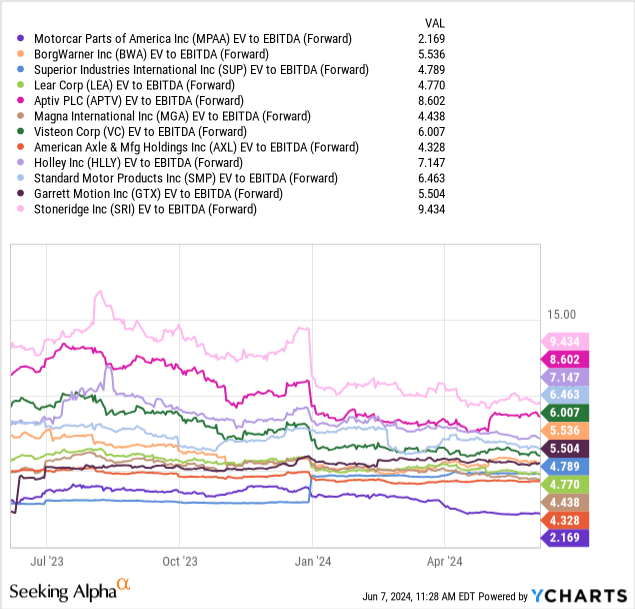Motorcar Parts of America, Inc. (NASDAQ:MPAA) has watched its stock price wilt over the last several years, mainly from a spike in interest expense on newly added debt. The quote slide from nearly $20 in November 2022 and a little over $10 in February 2024 has turned most investors against ownership. I cannot really blame them.
StockCharts.com – Motorcar Parts of America, 24 Months of Daily Price & Volume Changes
According to the Motorcar Parts of America website, the business is a leader in the remanufacture/supply of best-in-class underhood and undercar components, with 4,700+ employees in 13 locations across 7 countries. Thousands of individual products for nearly every vehicle on- and off-highway are sold to 7,700 automotive parts retailers and distributors. Main products include alternators, starters, wheel bearing and hub assemblies, brake calipers, brake master cylinders, brake power boosters, rotors, brake pads and turbochargers. In addition, the company designs and manufactures test solutions for performance, endurance, and testing of electric motors, inverters, alternators, starters, plus belt starter generators.
Motorcar Parts of America – May Investor Presentation
Some good news is the actual business is performing quite well with a 5-year high $48 million in operating income reported over the latest 12 months (partly the result of older cars staying on the road since the pandemic). And, with debt levels coming down, cash EPS are expected to improve rapidly beginning later in calendar 2024.
Seeking Alpha Table – Motorcar Parts of America, Analyst Estimates for 2024-26, Made June 6th, 2024
My bullish conclusion: if we do get a soft landing with falling interest rates into 2025, total “enterprise value” of equity plus debt is way too low. Really, MPAA is being priced like we are in serious recession, the same as late 2008 and early 2009. For me, this deep-value proposition leaves open plenty of room for share price upside, given the economy does not collapse anytime soon. Let me explain.
The Debt Problem
Below is a graph of the inverse relationship between rising financial debt (minus cash, excluding lease and other long-term contract obligations amounting to an extra $280 million at the end of December) and falling equity pricing since 2014. A second graph compares operating income levels remaining pretty steady around $40 million (before interest costs are factored into the equation), while net interest expense has ballooned with the jump in borrowing rates since early 2016 (plus contract fees). Notice when Motorcar Parts carried almost no debt in 2015-16, the stock quote was over $30.
YCharts – Motorcar Parts of America, Rising Debt Levels vs. Declining Share Price, 10 Years YCharts – Motorcar Parts of America, Operating Income vs. Net Interest Income/Expense, 10 Years

Another way to look at the situation is how the stock quote has performed since 1994 as a function of the debt-to-equity reading. Again, when debt is high, shares have languished for price. So, if management is committed to future investment gains for shareholders, debt reduction is the name of the game.
YCharts – Motorcar Parts of America, Debt to Equity, Since 1994
Recession-Like Bargain Valuation
With lots of moving parts on the financial engineering and leverage end of things, including a large one-time charge for an accounting change in FY 2024, my view is the best way to evaluate the company’s worth is through a total buyout value including both debt and equity totals. The enterprise value [EV] calculation is what I am reviewing today.
When we compare either the equity market capitalization or net enterprise value to tangible (net hard-asset) book value, you can see Wall Street is putting an unusual discount on the business vs. regular cost/depreciation accounting. We can argue the discount today is just as large as the depths of Great Recession during 2008-09 or the Dotcom Bust recession period of 2000-02. I can make a terrific buy argument from this dataset alone.
YCharts – Motorcar Parts of America, Tangible BV vs. Market Cap & Enterprise Value, Since 1994
Perhaps even better evidence of a long-term bottom can be found in the cash EBITDA and sales ratios vs. enterprise value. EV to trailing EBITDA stats over the past 30 years explain MPAA is an outstanding buy (assuming a major recession is avoided). The current 3.5x multiple is the lowest since 2013.
YCharts – Motorcar Parts of America, EV to EBITDA, Since 1994, Recessions Shaded
Then, when we compare/contrast Motorcar Parts of America’s EBITDA valuation to peers and competitors in the auto parts industry, the stock really stands out as a bargain. The 2.1x estimate is far below the industry median average of 5.5x (60% discount actually), and a much better deal than a year ago. My peer sort group includes BorgWarner (BWA), Superior Industries (SUP), Lear (LEA), Aptiv PLC (APTV), Magna International (MGA), Visteon (VC), American Axle (AXL), Holley (HLLY), Standard Motor Products (SMP), Garrett Motion (GTX), and Stoneridge (SRI).
YCharts – Motorcar Parts of America vs. Industry Peers, EV to Forward Estimated EBITDA, 1 Year
On EV to Revenue stats, the bullish setup continues to impress. MPAA’s 0.33x trailing number is actually LOWER than its important share price bottom in 2009. Only a few years including 1999, 2000, 2001 and several months during 2003 provided a smarter sales valuation over three decades.
YCharts – Motorcar Parts of America, EV to Revenues, Since 1994, Recessions Shaded
Reviewing peer valuations on sales projected for the rest of calendar 2024, the EV to forward Revenue ratio of 0.29x is roughly half the sector median average of 0.6x.
YCharts – Motorcar Parts of America vs. Industry Peers, EV to Forward Estimated Sales, 1 Year
Lastly, Wall Street loves free cash flow generation, just not from Motorcar Parts of America. Shouldn’t investors be flocking to the near 50% FCF yield, a 10-year high return on its abnormally-low $5 share price?
YCharts – Motorcar Parts of America, Free Cash Flow Yield, 10 Years
Final Thoughts
Despite decent underlying business trends, bearish analysts and investors may be overly focused on MPAA debt/interest expense (which could easily fall over time), worried about recession effects on auto parts demand in general, and only paying attention to the negative print of one-time accounting changes.
We’ll know more about the health of its operating business on June 11th, when the company’s March Q4 earnings release is due. Analyst projections are calling for normalized EPS of $0.16 on sales around $200 million. I will say it will be hard to post disappointing earnings at the same degree as last quarter.
Seeking Alpha Table – Motorcar Parts of America, Q3 FY 2024 Earnings Disappointment
For sure, the Motorcar Parts chart is downright ugly. However, price has held last’s year $4 bottoming area. Selling exhaustion indications are showing up in my short-term proprietary momentum formulas. Yet, I cannot guarantee a final bottom has been reached. All told, I suggest MPAA as a long-term undervaluation pick, pure and simple.
Recessions and the periods right before/after have not been very kind to MPAA investors. This is the primary reason to be cautious on this name. It is also the next logical excuse for weak share pricing, after excessive debt usage is considered.
What are other trading risks? MPAA is a smaller outfit, meaning big changes in operating fortunes will be observed by management and insiders before the general investing public. In this respect, I count a moderate level of insider buying activity as a positive. I would remind readers, smaller companies tend to have more share price volatility, and can encounter short-term swings that don’t make any sense. This is often the result of a single hedge fund or investor acquiring/liquidating a major position.
Nasdaq.com – Motorcar Parts of America, Insider Trading Activity, June 7th, 2024
On the upside, I strongly believe another auto parts manufacturer would be wise to acquire the firm at this low valuation. A takeover bid up to $10 per share would be highly accretive to a variety of larger players in the industry. A total buyout value around $350 million including the elimination of debt would allow a single owner to capture as much as $75 million in EBITDA and $50+ million in pretax operating income in 2025.
The ownership structure of insiders and management holding less than 5% of outstanding common shares should give any premium takeover offer high odds of success, especially a bid price almost double the current quote, near 52-week highs.
Seeking Alpha Table – Motorcar Parts of America, Shareholder Ownership Breakdown, March 2024
Weighing the risk of recession, against the potential rewards in a growing macroeconomic environment, I believe shares of Motorcar Parts of America are too cheap to ignore. I rate the stock a Buy, and own a small position. With a market cap around $100 million, MPAA is a speculative security, which argues in favor of keeping weightings on the low side in portfolio construction.
Thanks for reading. Please consider this article a first step in your due diligence process. Consulting with a registered and experienced investment advisor is recommended before making any trade.
Read the full article here









Leave a Reply